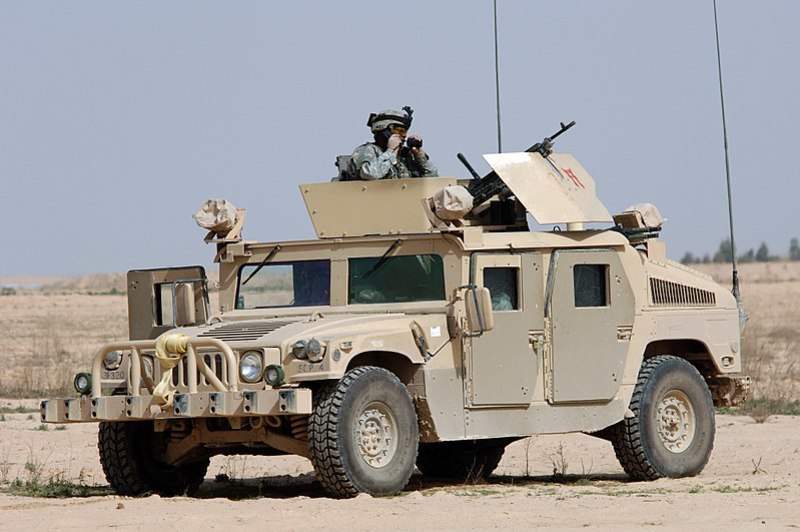In the opening years of Operation Iraqi Freedom (OIF) and Operation Enduring Freedom (OEF) it became increasingly clear that the well-worn and iconic High Mobility Multipurpose Wheeled Vehicle (HMMWV) was not suited to the rigors of counterinsurgency combat in Iraq and Afghanistan. In order to counter the HMMWV’s inherent vulnerability to improvised explosive devices (IEDs) – frequently the weapon of choice for outgunned insurgents – the U.S. military adopted the bulkier Mine-Resistant Ambush Protected (MRAP) vehicles. The MRAP vehicles proved a more effective bulwark against IEDs but presented a new set of serious challenges for the personnel operating them, namely a heightened risk of rollover accidents and decreased mobility.
Before the MRAP was introduced in 2007, the military tried to modify the HMMWV itself with intention of making it more survivable as a combat vehicle against IEDs and other threats. Between August 2003 and April 2005, the US Army commissioned an up-armoring program for its HMMWVs. New HMMWVs were manufactured and deployed with additional armor, whereas the vehicles already in theatre were retrofitted with armor kits.
Unfortunately, the added weight of the vehicle armor destabilized the HMMWVs and altered their center of gravity, making them harder for drivers to control. The now-armored turret was especially troublesome because it made the vehicles top heavy and therefore more likely to roll over. If a rollover did occur, it was now much harder for troops to egress from the HMMWV due to additional weight of the doors from the bolted-on armor.
The over-encumbered up-armored HMMWVs were a far cry from the vehicles in their original form, which were maneuverable in off-road conditions and not especially prone to rollovers thanks to their light weight and wide wheelbase. Indeed, according to statistics from a 2017 Military Medicine study, a greater proportion of the more severe class A and class B HMMWV accidents between 1991-2013 involved the up-armored M1114 variant of the vehicle, at 35 percent.
In 2007, the US Department of Defense made its first moves to augment and replace the military’s HMMWVs with the MRAP. From this point, until production ended in 2012, over 12,000 MRAPs saw service in Iraq and Afghanistan.
The MRAPS were designed with survivability in mind, especially against IEDs. The main improvement of the MRAP over the HMMWV is its V-shaped hull, which works by deflecting blasts away from the vehicle at acute angles. Many of the MRAPs also have increased passenger capacity.
As is often the case with technology, solving one problem led to another. The bulky armor of the MRAP, which protects its occupants against IEDs and small arms fire, makes it incredibly hefty and difficult to maneuver off-road. CAT II MRAPs can weigh anywhere between 65,000 and 75,000 pounds, making them even more unwieldy than the up-armored HMMWVs. This can make driving an MRAP up a relatively steep incline an uncomfortable task.
A report by the US Marine Corps Center in June 2010, brought several issues regarding the MRAP to attention. The report highlighted incidents of MRAPs rolling over after poorly constructed bridges and roads had given way under the weight of the vehicle. Moreover, roads in Iraq and Afghanistan are often characterized by steep crowns which curve down into waterways and pose an additional threat of drowning if occupants are unable to escape a flipped vehicle. The report found that almost 60 percent of MRAP accidents between November 7, 2007 and June 8, 2008 were due to rollovers caused by weak bridges, bad roads, or driver error.
With major combat operations drawing to a close in the Middle East, the question remains as to whether the military has learned and implemented lessons regarding vehicle safety. The Joint Light Tactical Vehicle (JLTV) and M-ATV are set to take over most of the aging HMMWV’s roles. Both vehicles are designed by Oshkosh and are intended to provide the level of protection granted by an MRAP but with greater maneuverability.
The JLTV and M-ATV both benefit from the TAK-4 independent suspension, originally used on the MTVR, which grants them greater potential to be used off-road. The new vehicles are capable of 70 percent of travel being off-road, compared to the HMMWV which was designed for 30 percent off-road travel. Other features, like electronic stability control (ESC) and front and rear display cameras may help prevent rollover accidents.
Despite significant improvements, an incident in which a JLTV rolled over in training last year at Fort Stewart’s tank trails is a reminder that no vehicle is infallible. Fortunately, no one was injured, but the military are looking for ways to improve visibility for crew members of the JLTV. Mitigating risks in new vehicles as the HMMWV is gradually phased out will require consistent testing, training and innovation.

